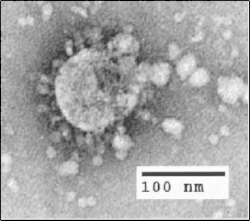SARS-CoV – Wikipedia
| Coronavirus | |
 Elektronmikroskopsbild av sars-virion. | |
| Systematik | |
|---|---|
| Ordning | Nidovirales |
| Familj | Coronaviridae |
| Underfamilj | Orthocoronavirinae |
| Släkte | Betacoronavirus |
| Art | Severe acute respiratory syndrome-related coronavirus |
| Virusstam | |
| Severe acute respiratory syndrome coronavirus | |
| Synonymer | |
| |
Severe acute respiratory syndrome coronavirus (SARS-CoV) är den stam av coronavirus som orsakar sjukdomen sars (severe acute respiratory syndrome).[2] Coronavirus har enkelsträngat positivt RNA-genom, ett så kallats RNA-virus, och infekterar epitelceller i lungorna.[3][4] Viruset infekterar människor, fladdermöss och palmmårdar.[5][6]
I slutet av 2002 rapporterades om en ny epidemi i Asien som visade sig bero på SARS-CoV.[7][8] Sjukdomen sars orsakade runt 8000 sjukdomsfall med över 750 dödsfall i sviterna.[9]
En pandemi på grund av sjukdomen COVID-19 2019–2021 visade stora likheter med sars, och viruset identifierades som sars-cov-2, ännu en stam av sars-relaterade coronavirus.
Referenser[redigera | redigera wikitext]
Noter[redigera | redigera wikitext]
- ^ ”ICTV Taxonomy history: Severe acute respiratory syndrome-related coronavirus” (på engelska) (html). International Committee on Taxonomy of Viruses (ICTV). https://talk.ictvonline.org/taxonomy/p/taxonomy-history?taxnode_id=20181868. Läst 27 januari 2019.
- ^ Thiel V (editor). (2007). Coronaviruses: Molecular and Cellular Biology (1st). Caister Academic Press. ISBN 978-1-904455-16-5
- ^ Fehr, Anthony R.; Perlman, Stanley (2015). ”Coronaviruses: An Overview of Their Replication and Pathogenesis”. Coronaviruses. Methods in Molecular Biology (Clifton, N.J.). "1282". sid. 1–23. doi:. ISBN 978-1-4939-2437-0. ”SARS-CoV primarily infects epithelial cells within the lung. The virus is capable of entering macrophages and dendritic cells but only leads to an abortive infection [87,88].”
- ^ Xing-Yi Ge, Jia-Lu Li, Xing-Lou Yang, et al. (2013). ”Isolation and characterization of a bat SARS-like coronavirus that uses the ACE2 receptor”. Nature 503 (7477): sid. 535–538. doi:. PMID 24172901.
- ^ Wong, Antonio C. P.; Li, Xin; Lau, Susanna K. P.; Woo, Patrick C. Y. (20 februari 2019). ”Global Epidemiology of Bat Coronaviruses”. Viruses 11 (2): sid. 174. doi:. ISSN 1999-4915. PMID 30791586. ”Most notably, horseshoe bats were found to be the reservoir of SARS-like CoVs, while palm civet cats are considered to be the intermediate host for SARS-CoVs [43,44,45].”.
- ^ Li, Fang (oktober 2013). ”Receptor recognition and cross-species infections of SARS coronavirus”. Antiviral Research 100 (1): sid. 246–254. doi:. ISSN 0166-3542. PMID 23994189. ”See Figure 6.”.
- ^ ”Remembering SARS: A Deadly Puzzle and the Efforts to Solve It”. Centers for Disease Control and Prevention. 11 april 2013. Arkiverad från originalet den 1 augusti 2013. https://web.archive.org/web/20130801143131/http://www.cdc.gov/about/history/sars/feature.htm. Läst 3 augusti 2013.
- ^ ”Coronavirus never before seen in humans is the cause of SARS”. United Nations World Health Organization. 16 april 2006. Arkiverad från originalet den 12 augusti 2004. https://web.archive.org/web/20040812124322/http://www.who.int/mediacentre/releases/2003/pr31/en/. Läst 5 juli 2006.
- ^ Folkhälsomyndigheten (2020-01-21) Sjukdomsinformation om coronavirus inklusive sars och mers, läst 2020-01-31
Externa länkar[redigera | redigera wikitext]
 Wikimedia Commons har media som rör SARS-CoV.
Wikimedia Commons har media som rör SARS-CoV.
|


 French
French Deutsch
Deutsch